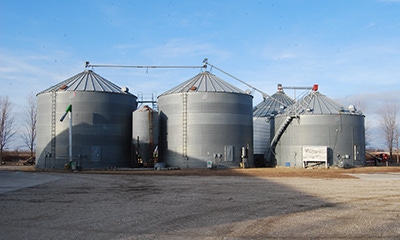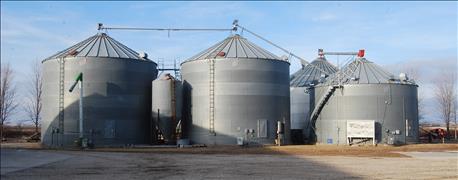February 16, 2016

Editor’s note: Steve Johnson is an ISU Extension farm management specialist in central Iowa. You can contact him at [email protected].
It’s February and farmers need to be thinking about when they will need to sell some corn or soybeans. They have bills to pay and need to generate cash to pay them. That usually means during February and March farmers have to make tough decisions regarding the cash grain market.
At grain marketing meetings with farmers this past week we discussed the use of basis contracts, one of the tools in the marketing toolbox. Basis contracts are available at grain elevators and other buyers of grain throughout Iowa.

USING A BASIS CONTRACT: Understand the risk of being “long futures” and know your cash-flow of cash funds. Advantages of a basis contract include elimination of storage costs and basis risk, reduced concern for on-farm stored corn quality and freeing-up storage space for 2016 crop.
Consider strategies and tools for marketing 2015 crop corn
How does a basis contract work? You simply sell the cash and work with your grain merchandiser. At our meetings this week, we looked at a number of strategies and tools for marketing old-crop corn, the 2015 crop. Iowa farmers last year produced the largest corn and soybean crops they’ve ever grown. But for about 90% of Iowa’s farmers, they’re still storing bushels that aren’t priced. And we’re now in the second week of February and looking at the March futures prices about 50 cents a bushel below the fall high for soybeans and 35 cents below the fall high for corn. Not only didn’t we get the crop priced, we’ve actually lost money storing these bushels over the last four or five months.
Take a look at some marketing strategies. Maybe staying long futures via a basis contract or minimum price contract, and then sell should prices rally in the spring. But eliminating basis risk and eliminating storage cost should be your goal. The clock is really ticking, especially on commercially-stored corn and soybeans.
Basis contracts can start generating cash flow as you need it
What advice do we have for farmers, so they can start generating cash flow as soon as possible? Work with your grain merchandiser. Basis contracts, or minimum price contracts, aren’t new. They are readily available and you need to visit your grain merchandiser and discuss what the transaction would look like if you hauled him some bushels. And he is going to buy futures on your behalf. For example, is the grain merchandiser going to hold a percentage of your cash proceeds for a call option or to make margin calls?
You can go to the Iowa Commodity Challenge website and learn about basis contracts and other grain marketing tools. Just Google “Iowa Commodity Challenge” and it takes you there. In cooperation with Iowa Farm Bureau, we’ve recorded 12 videos on how to use various grain marketing tools and written a 60-page workbook. These are helpful resources, available at the Commodity Challenge website. The Iowa Commodity Challenge and other grain marketing information are available on ISU’s Ag Decision Maker site at extension.iastate.edu/agdm.
Also, we’ve written a “Crop Marketing Strategies” newsletter for February, now running on the ISU Extension website. The newsletter is titled “Selling Cash; using a Basis Contract to “Stay Long” Corn”. It’s also available at extension.iastate.edu/polk/farm-management. Following are highlights from the Crop Marketing February newsletter.
~~~PAGE_BREAK_HERE~~~
Selling cash and using a basis contract to “stay long” corn
Large U.S. corn ending stocks estimates were confirmed in January to be more than 1.8 billion bushels for the 2015-16 marketing year that ends Aug. 31, 2016. By late summer, farmers will be holding the largest number of bushels in storage (on-farm and commercial) in more than 10 years.
Futures carry: Note on the upper-portion of the chart below updated Feb. 1 there is very little carry in the old corn futures markets from March ($3.71) to May ($3.76) to July ($3.80). This would be a 7-cents carry from March to May and a 9-cent carry from March to July. December is considered a new crop futures market, and is featured here for illustrative purposes only.

Source: Iowa Commodity Challenge, Feb. 1, 2016
On the top of each bar chart are local cash bids for a variety of delivery months. These bids are tracked for a central Iowa co-op as a part of the Iowa Commodity Challenge.
Corn basis trends: To determine the basis, simply subtract the cash bid offered from the corresponding futures prices above. An example would be February delivery. Cash bid equals $3.39 minus $3.71 equals -32-cents-per-bushel basis or 32 under the nearby futures. In Iowa, the basis tends to be a negative number since the cash price rarely exceeds the futures price. The basis for June delivery would be -36 cents per bushel or 36 under the July futures price. By tracking basis year around for three to five years where you typically deliver corn can help determine if these are good basis bids for February and June time frames, respectively.
Cost of grain ownership: The cost of ownership line graph below assumes an early-October 2015 harvest cash price of $3.43 per bushel for corn. Interest on debt accruing for stored bushels is at 5% annual percentage rate (APR). This $3.43 is the actual average cash price paid across Iowa. Cash prices are tracked by the Iowa Department of Agriculture. The blue dashed line reflects on-farm storage cost of 1cent per bushel per month. The red dashed line represents commercial storage costs of 14 cents per bushel for the first three months and 2.8 cents per bushel per month, thereafter. An additional interest charge of 1.5 cents per bushel per month is accruing for both on-farm and commercial storage bushels.

Source: Iowa Commodity Challenge, Feb. 1, 2016
The cash price bid weekly is reflected on the lower solid line with the dots. This allows you to compare the cost of ownership of these stored bushels against the cash price bids weekly since early October. Once these bushels are harvested and stored, the goal should then be to sell these bushels at the highest net return over the cost of ownership. To date, the net return is a negative 8 cents per bushel for on-farm storage and a negative 15 cents per bushel for commercial storage. In other words, selling cash bushels in this example now would result in a negative return to storage considering the cost of grain ownership.
~~~PAGE_BREAK_HERE~~~
Continuing to store bushels into the late spring means that the higher cash price per bushel is required to overcome this cost of ownership. So either the futures price will need to increase and/or the basis needs to narrow (become less negative).
Remember, by late summer, most all the old crop corn bushels are owned by farmers, not the processors or elevators. Farmers have not been aggressive in selling ahead their 2014 and 2015 crops. Looking ahead, storage could be in short supply by September 2016, as the old crop bushels are in the way of the new crop corn and soybean bushels. Should the 2016 crop get planted in a timely fashion, expect concern to build for not only lower futures prices by late summer, but also wider basis.
Consider using a basis contract; it’s time to move stored bushels
Many corn processor bids remain attractive this winter, reflected by an attractive basis. Farmers need to generate cash and have time now to move many of these stored bushels. The winter storage conditions have not been ideal, thus corn stored in on-farm facilities may be subject to price dock or even rejected should moisture levels or quality concerns arise at delivery.
A basis contract could encourage farmer movement of cash corn in the early winter or again in the early spring when basis typically narrows. This is especially true for commercially stored bushels with higher fixed costs and on-farm stored bushels that need to move before the late summer months to make room for the 2016 crop.
A basis contract is offered by most grain merchandisers. These cash contracts tend to be offered in 5,000 bushel increments to match the futures contract that underlies the transaction. So when a farmer delivers cash corn, the merchandiser buys or goes “long futures” on behalf of the farmer. The merchandiser will likely charge a small service fee of 1 cent to 2 cents per bushel subtracted when the basis contract is terminated.
Upon delivery of the bushels, a farmer receives roughly 80% of the value of the cash corn. The 20% balance of the cash sale is held by the merchandiser to make potential margin calls should futures prices decline. Any excess funds minus the 1 cent to 2 cents per bushel service fee are returned to the farmer upon termination of the basis contract.
What farmers need to do when working with grain merchandiser
The farmer needs to initiate with the merchandiser a date and price at which he/she wishes to have this “long futures” position lifted on their behalf. Consider being “long” July corn futures contract to increase the chance of benefitting from a spring price rally. This is the typical timeframe when corn futures prices rally with the uncertainty for feed grain production in the northern hemisphere.
Note that the July ‘16 corn contract will have a first notice day of June 30. Thus a farmer with a July basis contract will work with their grain merchandiser to “lift this long” July futures (short position) on or prior to this date. A price objective might be the $3.93 to $4.03 per bushel levels reflected in the July ’16 futures chart below.

Source: www.jimwyckoff.com, Feb. 1, 2016
Conclusion: Farmers should discuss with the merchandiser at the time of initiating a cash sale of grain the use of a basis contract, which still has futures price risk. Simply selling cash and buying a July futures through a commodity broker accomplishes the same strategy. Understand the risk of being “long futures” and the flow of cash funds. Advantages of a basis contract include: elimination of storage costs and basis risk, reduces the concern regarding on-farm stored corn quality; and it frees up storage space for the 2016 crop.
For farm management information and analysis visit ISU's Ag Decision Maker site at extension.iastate.edu/agdm; ISU farm management specialist Steve Johnson's site is at extension.iastate.edu/polk/farm-management.
You May Also Like




